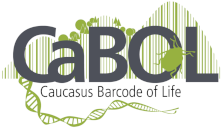A key element to the first projects (e.g. Kintrishi transect in GGBC) is DNA barcoding – future projects will build on this infrastructure.
What is DNA barcoding?
DNA barcodes (see Wiki) are very short gene fragments which are used as unique DNA signatures. Based on these signature sequences, unknown individuals (animals, plants, fungi, microbes) can be assigned to species. Each species is characterized by a distinct barcode. Using DNA barcodes, challenging species identifications can be readily solved: barcoding opens up species-rich groups and cryptic species complexes to identification, and allows working on difficult developmental stages (spores, eggs, larvae) or tissue fragments (e.g. insect legs, plant roots, fungal hyphae or hair). Here are ten good reasons for DNA barcoding (pdf by GBOL).
An established DNA barcode reference database offers even non-specialists a rapid, reliable and cost-effective tool for species identification. Using DNA traces organisms leave in their environment, even water, soil or insect trap samples can be analyzed without sorting individuals and without actually using tissue samples.
Building the barcode reference database for the Caucasus
The first step in DNA barcoding projects is to build a reference database which associates the scientific species names with their signature DNA sequences. Building a barcode reference library is a laborious process. Individual specimens need to be collected (several per species) and carefully identified morphologically before their DNA sequence is deciphered and added to the database. Within CaBOL, we are taking the first steps to compile a publicly accessible reference database for with species-specific DNA barcode sequences Georgia, aided by the experiences gained in the German Barcode of Life project. We hope that with additional partners, we will be able to expand this endeavor to further countries of the Caucasus region. DNA barcoding offers a very convenient means to catalog, understand and ultimately preserve the biological heritage of the Caucasus.
The CaBOL Workflow

- Sampling: DNA barcoding projects obtain specimens from a variety of sources: Private collections of amateur taxonomists and museum collections (e.g. natural history museums, zoos, botanical gardens and seed banks). Museum specimens will be carefully checked for their DNA quality to ensure reliable DNA-barcoding. Fresh material collected in the field by scientists & citizen scientists. CaBOL taxonomists depend on the enthusiastic and active support of qualified citizen scientists. They contribute significantly to the collection, appropriate conservation and identification of organisms for DNA barcoding.
- Collection data: For each sample, taxonomic identification and collection data (i.e. sampling location and date, geographic coordinates, collection method, collectors name, etc.) will be recorded.
- Photographs: Organisms will be photographed in their natural habitat and in the laboratory.
- Collection: Vouchers will be stored in collections of the respective CaBOL institutions.
- DNA Extraction: In the laboratory technicians isolate a small piece of tissue from each specimen and extract DNA.
- PCR: The DNA barcode region will be isolated and replicated using a process called PCR (polymerase chain reaction) amplification.
- Sequencing: The DNA barcode will be generated, consisting of a few hundred base pair long sequence of four different letters (e.g. CAATCGGTAA …). These letters represent the four nucleic acids (Adenin, Guanin, Thymin, and Cytosin) constituting the DNA.
- Data validation: Sequences and metadata (collection data, taxonomy, photographs) of the samples will be tested for completeness and quality by CaBOL scientists.
- NCBI: The species profile including the DNA sequence is fed into global reference databases for DNA barcodes.
The displayed workflow corresponds the German Barcode of Life workflow, one objective of CaBOL is the implementation of this workflow in the Caucasus.
Projects overview